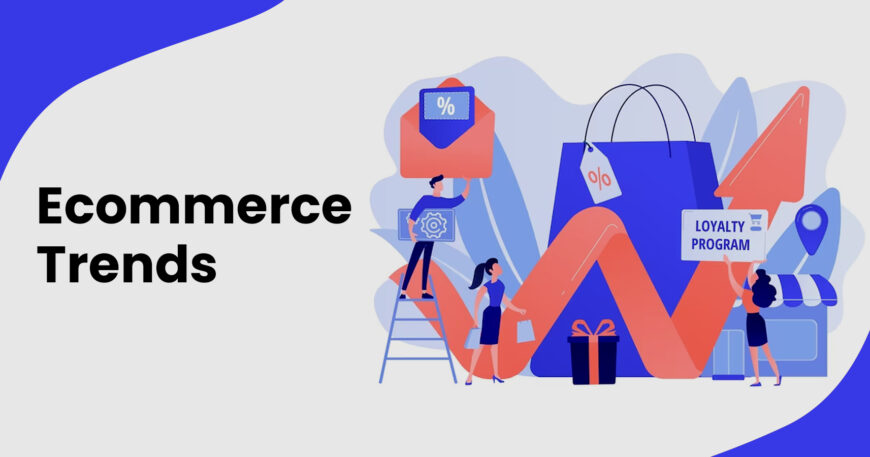The eCommerce industry constantly evolves, and staying on top of the latest ecommerce trends can be the key to success. But what are the directions on the horizon for 2023?
As the pandemic continues to push consumers towards online shopping, e-commerce trends have become more critical than ever. Rapid technological advancements and changing consumer behavior are transforming the eCommerce landscape. From virtual reality shopping to social media commerce, the possibilities are endless.
Businesses need to stay updated with the latest ecommerce trends to keep up with the competition and connect with their customers. This article will explore the top 15 eCommerce trends to look out for in 2023. Whether you’re an entrepreneur looking to launch a new business or an established retailer hoping to stay ahead of the curve, these emerging trends in ecommerce will shape the future of eCommerce.
1. Augmented and Virtual Reality
Customers can study products attentively and increase their purchasing confidence using augmented and virtual reality, which provides an immersive experience for viewers.
By 2031, the AR/VR industry is projected to be worth $856.2 billion, with a ten-year CAGR of 41.1%.
The natural, physical world is combined with computer-generated sights, sounds, or other inputs in augmented reality (AR). While employing specific headgear, virtual reality (VR) immerses the user in a scene created by a computer that appears to be accurate.
To provide a more immersive buying experience, several ecommerce firms are implementing AR and VR technology.
2. AI Enhances User Experience By Personalizing It
Personalization is one of the best uses of AI for organizations. Personalization entails adjusting the user experience to reflect what the business has discovered about them. According to a report, 80% of customers are more inclined to buy from a company again if they have a personalized purchasing experience.
3. CRM Creates A Community Around Your Online Store
CRM creates a community around your ecommerce brand by assisting you in better understanding the wants and needs of potential clients. This helps you forge stronger bonds with clients and increase client loyalty.
Ecommerce organizations can manage client interactions with the help of customer relationship management (CRM), which consists of tools and tactics. 92% of customers would stop doing business with a company after two or three unpleasant experiences; therefore, having a robust CRM strategy is crucial.
CRM helps business leaders better comprehend the demands and behaviors of their customers. As a result, ties are strengthened, and a devoted consumer base is created.
By 2028, the CRM market is projected to reach over $128 billion. More than 91% of businesses with 10 or more employees also use CRM to control client conversations.
4. Hybrid Commerce
Combining your online channels with the in-person shopping experience is what hybrid commerce does best to increase conversion rates.
These e-commerce trends encourage hybrid commerce, or omnichannel selling, by integrating several channels and platforms to offer a smooth experience.
Implementing click-and-collect is a simple approach to omnichannel retailing. Customers can use this service, often known as “buy online, pick up in-store” (BOPIS), to check out online and pick up their products at the retailer or pickup location.
The popularity of click-and-collect has increased due to the convenience of online shopping, quick in-store visits, and free delivery. By 2025, it is anticipated to be worth more than $154 billion. Well-known retailers like Walmart, Target, and IKEA provide this service.
5. Growth of Subscription-Based Models
Subscription-based models are becoming increasingly popular in various industries. In this business model, customers pay a recurring fee to access a product or service. This model provides predictable and stable revenue streams, enhances customer loyalty and retention, and allows for pricing and packaging option flexibility.
Companies can also gather customer data and insights, helping them tailor their products and services to meet customer needs. Examples of subscription-based models include Netflix, Amazon Prime, Dollar Shave Club, and Blue Apron.
6. Customer Support as a Top Focus
Customer service is still a top priority because it favorably affects consumers’ purchase decisions, fosters loyalty, enhances a brand’s reputation and increases eCommerce sales.
Customer service has always been crucial to businesses and will continue to be so. Problems with goods or services may discourage both current and potential customers. In the end, a company is responsible for providing competent support.
According to 81% of consumers, good customer service encourages repeat business. Response time is crucial, and 60% of clients concur that a benchmark for quick responses is 10 minutes or less.
7. Develop A Strategy For Social Selling To Benefit From Its Growth
Plan your social selling strategy to benefit from its growth because social commerce is affordable and promotes in-app purchases. Two of the newest e-commerce trends and concepts to use with this tactic are influencer marketing and live shopping.
Making the most of mobile purchasing requires using successful retail sales channels, such as social networking. According to research, mobile devices account for 80% of social media traffic. In addition, 79% of smartphone users had bought something on their portable devices.
Social media commerce sales, already a multi-billion dollar business, are anticipated to triple by 2025 and reach $1.2 trillion. Additionally, the number of people using social networks worldwide surpassed the four billion level in 2021 and is expected to approach six billion by 2027.
8. Use of Influencers in eCommerce
Influencers are individuals who have a large social media following and can influence their followers’ purchasing decisions. In emerging ecommerce trends, influencers often promote products and services to their followers.
Using influencers in eCommerce can increase brand awareness and reach, boost engagement rates and conversions, enhance credibility and trust with consumers, and allow companies to reach niche markets and target specific demographics. Some famous examples of companies that use influencers in eCommerce include Kylie Cosmetics, Fashion Nova, MVMT Watches, and HelloFresh.
9. Increased Use of Video Marketing
Video marketing has numerous advantages, such as increased engagement and brand awareness, higher conversion rates, improved search engine rankings, better audience targeting, and better storytelling and emotional connections with viewers. Therefore, the increased use of video marketing will be one of the ecommerce trends we can expect.
Many companies have successfully used video marketing to promote their products and services, such as Nike’s “Dream Crazy” ad featuring Colin Kaepernick, which sparked controversy and garnered widespread attention, Dollar Shave Club’s viral “Our Blades Are F***ing Great” video, which helped the company attract millions of subscribers, and Old Spice’s “The Man Your Man Could Smell Like” campaign, which became a cultural phenomenon and boosted sales.
10. Increased Emphasis on Sustainability
Sustainability refers to meeting the needs of the present generation without compromising the ability of future generations to meet their own needs. In simple terms, sustainability aims to create a balance between environmental, social, and economic aspects of development.
Emphasizing sustainability has numerous benefits, such as reducing environmental degradation and preserving natural resources, improving social and economic conditions, promoting innovation and efficiency, enhancing corporate social responsibility, and creating a better future for future generations.
Many companies and organizations have taken steps to emphasize sustainability in their operations, such as implementing eco-friendly practices, reducing their carbon footprint, using renewable energy sources, promoting social responsibility, and adopting sustainable business models. For instance, Coca-Cola has pledged to reduce water usage in its operations, Nike has introduced sustainable materials in its products, and Tesla has made electric cars more accessible.
11. Multiple Payment Choices Availability
Don’t let your website’s lack of support for their preferred payment methods force you to lose out on potential customers. To gain a head start on the trends in ecommerce, think about providing well-liked and unconventional payment choices.
Due to the practically widespread use of mobile devices, offering mobile payment solutions has emerged as one of the top eCommerce trends worldwide.
12. Increased Use of Chatbots for Customer Service
Chatbots are computer programs designed to simulate conversation with human users, typically via messaging platforms, websites, or mobile applications. Chatbots use artificial intelligence and natural language processing to understand user queries and provide relevant responses.
Many companies have already adopted chatbots for customer services, such as Sephora, which uses a chatbot to provide personalized beauty advice, H&M, which uses a chatbot to recommend outfits to customers; and Domino’s Pizza, which allows customers to order pizza through a chatbot. Chatbots are also increasingly used in the banking, healthcare, and travel industries to provide quick and efficient customer service.
13. Marketing Automation increases Conversions And Productivity
Marketing automation increases productivity and conversions; it’s a terrific method to organize your workflow and make it more effective.
Advertising, outreach, and follow-up emails are examples of everyday marketing chores that can be automated for organizations with machine learning.
This method is not dependent on pre-written communications. To develop customized messages for each stage of the purchasing process, it collects and analyzes client data. Better customer engagement and higher conversion rates are the outcomes.
By 2027, marketing automation is expected to reach $9.5 billion, growing at 12.8%. Marketing automation saves more than six hours a week due to its efficiency in optimizing procedures.
14. Increased Use of User-Generated Content
User-generated content (UGC) refers to content created by users or customers, such as reviews, social media posts, photos, and videos, that promote or reference a brand, product, or service.
User-generated content has several advantages: increased authenticity and credibility, higher engagement and brand loyalty, reduced marketing costs, better audience targeting, and improved search engine rankings.
Many companies have leveraged user-generated content to promote their products and services, such as Airbnb’s “Night At” campaign, which invited customers to stay overnight in unusual locations and share their experiences on social media, Coca-Cola’s “Share a Coke” campaign, which encouraged customers to share photos of their personalized Coke bottles, and GoPro’s “Photo of the Day” program, which showcases user-submitted photos and videos taken with GoPro cameras.
15. CRO Strategy
Converting traffic into paying clients is one of the essential tasks when running an eCommerce website. Conversion rate optimization (CRO) techniques encourage website users to purchase your goods or subscribe to your newsletter.
CRO will become increasingly customer-focused in the emerging ecommerce trends. More marketers will pay attention to learning what draws and discourages visitors from taking action to ensure the optimum user experience.
Final Thoughts
The eCommerce landscape is rapidly evolving, and businesses must stay ahead of the curve. As we head into 2023, several emerging ecommerce trends are set to revolutionize the industry.
As eCommerce continues to shape the future of retail, businesses must keep an eye on the latest e-commerce trends and adapt their strategies accordingly. By doing so, they can attract new customers, retain existing ones, and ultimately drive growth and success in the years ahead.
Do you have questions about the latest trends in ecommerce industry? Comment down below and we’ll gladly answer them!





